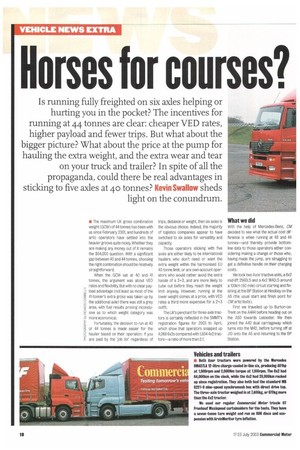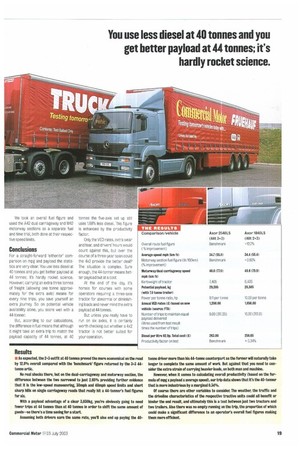Horses for courses?
Page 18

Page 19

If you've noticed an error in this article please click here to report it so we can fix it.
Is running fully freighted on six axles helping or hurting you in the pocket? The incentives for running at 44 tonnes are clear: cheaper VED rates, higher payload and fewer trips. But what about the bigger picture? What about the price at the pump for hauling the extra weight, and the extra wear and tear on your truck and trailer? In spite of all the propaganda, could there be real advantages in sticking to five axles at 40 tonnes? Kevin Swallow sheds light on the conundrum.
E The maximum UK gross combination weight (GCW) of 44 tonnes has been with us since February 2001, and hundreds of artic operators have settled into the heavier groove quite nicely. Whether they are making any money out of it remains the $64,000 question. With a significant gap between 40 and 44 tonnes, choosing the right combination should be relatively straightforward.
When the GCW sat at 40 and 41 tonnes, the argument was about VED rates and flexibility. But with no clear pay , 2, load advantage (not least as most of the 41-tonner's extra gross was taken up by the additional axle) there was still a grey area, with fuel results proving inconclu i sive as to which weight category was more economical.
Fortunately, the decision to run at 40 or 44 tonnes is made easier for the g haulier based on their operation. If you are paid by the 'job lot' regardless of
trips, distance or weight, then six axles is the obvious choice. Indeed, the majority of logistics companies appear to have switched to six axles for versatility and capacity.
Those operators sticking with five axles are either likely to be international hauliers who don't need or want the extra weight within the harmonised EU 40-tonne limit, or are own-account operators who would rather avoid the extra hassle of a 3+3, and are more likely to cube out before they reach the weight limit anyway. However, running at the lower weight comes at a price, with VED rates a third more expensive for a 2+3 Outfit.
The UK's penchant for three-axle tractors is certainly reflected in the SfylMT's registration figures for 2003 to April, which show that operators snapped up 4,068 6x2s compared wrth 1,834 4x2 tractors—a ratio of more than 21.
What we did
With the help of Mercedes-Benz, CM decided to see what the actual cost difference is when running at 40 and 44 tonnes—and thereby provide bottomline data to those operators either considering making a change or those who, having made the jump, are struggling to get a definitive handle on their changing costs.
We took two Axor tractive units, a 6x2 mid-lift 2560LS and a 4x2 1840LS around a 100km (60 mile) circuit starting and finishing at the BP Station at Hinckley on the AS (the usual start and finish point for CM artic tests).
First we travelled up to Burton-onTrent on the 4444 before heading out on the A50 towards Leicester. We then joined the A42 dual carriageway which turns into the M42, before turnIng off at J10 onto the A5 and returning to the BP Station. We took an overall fuel figure and used the A42 dual carriageway and M42 motorway sections as a separate fuel and time trial, both done at their respective speed limits.
Conclusions For a straight-forward 'either/or' comparison on mpg and payload the statistics are very clear. You use less diesel at 40 tonnes and you get better payload at 44 tonnes; it's hardly rocket science. However, carrying an extra three tonnes of freight (allowing one tonne approximately for the extra axle) means for every nine trips, you save yoursetf an extra journey. So on potential vehicle availability alone, you score well with a 44-tanner.
But, according to our calculations, the difference in fuel means that although it might take an extra trip to match the payload capacity of 44 tonnes, at 40 tonnes the five-axle set up still uses 1.68% less diesel. This fgure is enhanced by the productivity factor.
Only the VED rates, extra wear and tear, and drivers' hours would court against this, but over the course of a three-year span could the 4x2 provide the better deal? The situation is complex. Sure enough, the 44-tonner means better payload but at a cost.
At the end of the day, it's horses for courses with some operators requiring a three-axle tractor for abnormal or diminishing loads and never mind the extra payload at 44 tonnes.
But unless you really have to run on six axles, it is certainly worth checking out whether a 4x2 tractor is not better suited for your operation.
















































































































































































